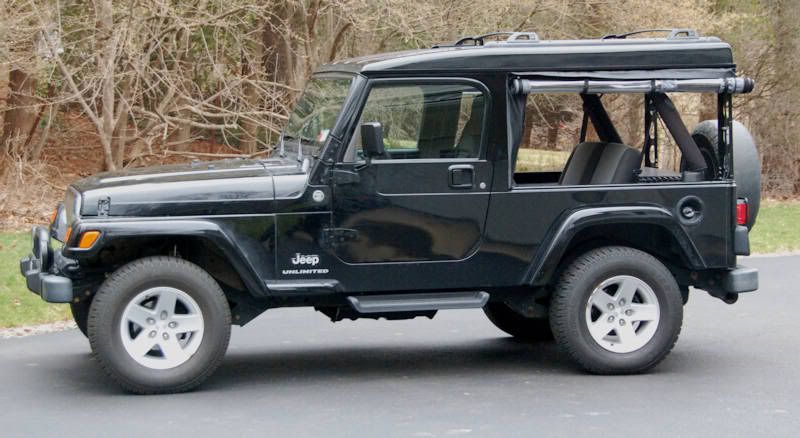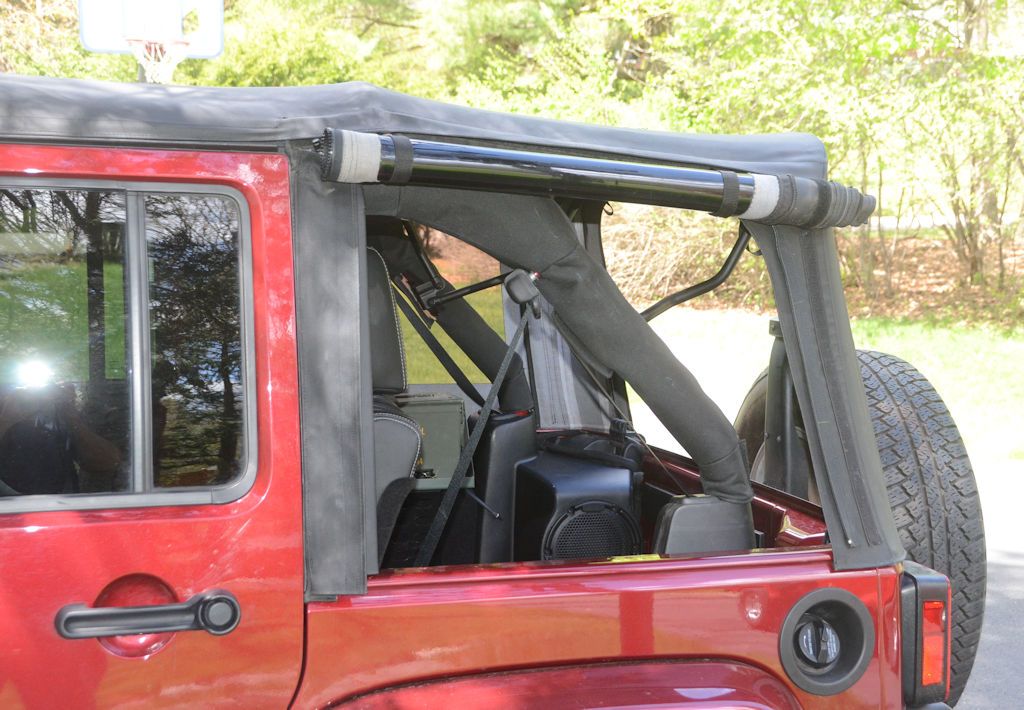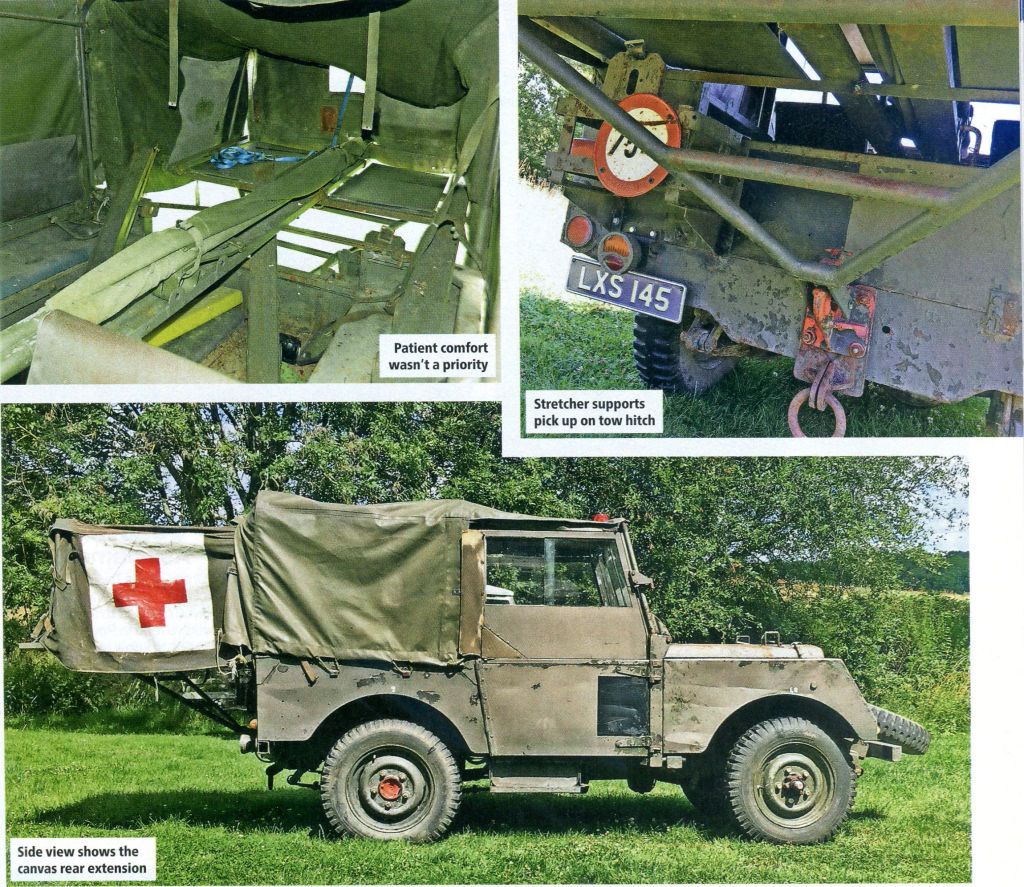You are using an out of date browser. It may not display this or other websites correctly.
You should upgrade or use an alternative browser.
You should upgrade or use an alternative browser.
Land Rover ideas for Jeeps
- Thread starter jscherb
- Start date
jscherb
Expedition Leader
Roof Locker
This is an interesting product that could easily be built for a Jeep, although it may work better under the Land Rover roof due to interference from the roll bars in the Jeep.

The photo above doesn't show the product very well; the product web site: https://www.davidbowyer.co.uk/_main/land_rover_roof_lockers.htm has a few better photos:

Not sure the how well the locker idea would work well in a Jeep hardtop, but I designed and built something that does work well. It's a Molle panel that mounts above the cargo area and swings down for access. When stowed it's above the bottom of the roll bar, so it's out of the way (and out of the view in the rear view mirror). There are two versions, one is a Molle panel and the other is a lockable storage compartment. Both work with the hardtop, soft top or no top.
This is an interesting product that could easily be built for a Jeep, although it may work better under the Land Rover roof due to interference from the roll bars in the Jeep.

The photo above doesn't show the product very well; the product web site: https://www.davidbowyer.co.uk/_main/land_rover_roof_lockers.htm has a few better photos:

Not sure the how well the locker idea would work well in a Jeep hardtop, but I designed and built something that does work well. It's a Molle panel that mounts above the cargo area and swings down for access. When stowed it's above the bottom of the roll bar, so it's out of the way (and out of the view in the rear view mirror). There are two versions, one is a Molle panel and the other is a lockable storage compartment. Both work with the hardtop, soft top or no top.
jscherb
Expedition Leader
You could sell those patches. Velcro on the back would be even better. I would buy one, as would a lot of four-wheelers and overlanders. .
A company made a sample for me. They have an iron-on back but could also be sewn on. They can be made for a reasonable price. Anyone think it's worth getting some made?

jscherb
Expedition Leader
The patch company tells me they can do either iron-on or velcro for the same price, so if anyone else has input on that let me know.You know I do. I'll buy a couple. Yellow's not my favorite color though, but not a show stopper. You know Overlanders like their patches (especially with Velcro on the back).
Heck - maybe they could sell them here on the expedition portal.
jscherb
Expedition Leader
I told the patch company to go ahead and make 25 patches with velcro backs. If things go according to plan, the patches should be ready to sell and ship in about two weeks. Since I don't sell anything and don't ever want to, I talked to another company about selling them (the patch company isn't in the business of selling single patches to people, they're just a manufacturer).
For the record - I won't be getting any money from these patches. I'm doing this mostly for the fun of it, but also because I think there could be a market for a fun series of patches like this - I convinced the company that agreed to sell them to do this first batch as a test and if they do well I would do other designs for them (and no money to me for those either, I'd do more designs just for fun).
For the record - I won't be getting any money from these patches. I'm doing this mostly for the fun of it, but also because I think there could be a market for a fun series of patches like this - I convinced the company that agreed to sell them to do this first batch as a test and if they do well I would do other designs for them (and no money to me for those either, I'd do more designs just for fun).
alanymarce
Well-known member
Of all the international overlanders I've bumped into around the world, I'd say a small percentage carry two spares.
I genuinely think it's a holdover from the 80s and 90s when tires weren't nearly as tough as they are now and failures were more common.
It's extremely rare to destroy a tire these days, especially if you don't overload.
-Dan
a) "Big trips":
1) South America - we carried one spare and experienced 5 punctures, three were sharp debris (nails etc.) on the highway, two were sharp rocks on one rough road in Bolivia (fixed one, the other was not possible to fix). It was a little worrying to travel the next 200 or so Km with no spare however we had no further problems. Didn't need a second spare.
2) Africa - we took two spares - had zero punctures... Didn't need a second spare. PS - we did use someone else's vehicle for a week in Uganda (not our own) and had punctures (the tyres were in poor shape), however we fixed them and didn't need a second spare.
3) Australia - started out with one spare, then for the GRR added a second (strong recommendation from WA Roads). We had one puncture in WA (not on the GRR), and none since. Didn't need a second spare.
So we've actually carried a second spare for about 65,000 Km out of about 140,000 Km on "big trips" and have never needed it.
b) "Normal life":
Since the 1970s I cannot remember more than one puncture in 40 years, and that was easy to fix. This includes driving in many parts of the world on many "tough" roads. The one puncture? Central Sahara Desert on a 450 Km circuit, in an area where the entire surface was sharp volcanic shards of rock, shattered in the extreme temperature changes. We fixed it and continued on our way - no need for a second spare.
I love the idea of a spare on the bonnet, I looked for a 33" tire with aggressive tread that is say only 5-6" wide, but could only find front tires for drag cars, maybe have them retreaded and use similar whell but narrower. Would cut down on weight and amount of tire you have to bury in hood.
jscherb
Expedition Leader
There are two steps in mold making that are best done by spraying: after the surface is coated in mold release wax, several coats of PVA mold release are sprayed over the wax. This can be done very nicely with a $12 Harbor Freight spray gun (and a compressor to provide the air for it). Once the PVA has dried, the next step is to spray gelcoat on the surface - gelcoat forms the surface of the mold (and when making a part in the mold, gelcoat is sprayed on to form the outside surface of the part). Gelcoat is a thickened resin and doesn't spray well from a conventional spray gun so it's best applied with a gelcoat gun, I have the $125 one on this page and I've been using it for years: http://uscomposites.com/equipment.htmlI sure could use a top layer on the top of my jeep here in Atlanta, where we experience 90 days for three months. You mentioned you had to spray part of it to make a mold, does that require special equipment?
Making a mold from the top of a hardtop and then making a Tropical Roof in that mold is a pretty straightforward fiberglass project. There are many books on fiberglass out there that will explain the process and I'm always here to provide and advice and guidance you might need.
jscherb
Expedition Leader
Another way you might get a Tropical Roof panel... since you have an LJ Safari Cab, you could ask Gr8Tops if they'll mold one for you. They could mold you a standard roof panel it in their Safari Cab roof mold and you would trim it to an appropriate size to serve as a Tropical panel and mount it above the main roof on spacers. A mold you'd make on top of the roof would be basically the same as the mold that made the roof, the only difference between the full roof mold shown below (this one is my LJ Safari Cab roof mold, not Gr8Tops mold) and one you'd make for the purpose of making a Tropical panel is you wouldn't need to make the mold go all the way to the drip rails as this one does, you'd just mold a section that would be the size of the Tropical panel, but a full roof mold like this one would serve just fine for making a Tropical panel.I sure could use a top layer on the top of my jeep here in Atlanta, where we experience 90 days for three months. You mentioned you had to spray part of it to make a mold, does that require special equipment?

jscherb
Expedition Leader
One feature I wish Jeep soft tops had is roll-up sides. They've been part of Land Rover soft tops back to the early Series models.
On a Series:



And on a Defender:

I like the roll-up soft side idea a lot, so I designed them as an optional feature of my Safari Cab hardtops, in the summer I remove the hard sides and install the soft sides. This is a feature Land Rovers don't have, the only way to get roll-up sides on a Land Rover is with the soft top, they're not an option for the hard top.


Without the hard rear panel and barn door:

Rolled down:

My JKU Safari Cab has optional roll-up soft sides as well.
BTW Jeep factory soft top sides can be modified to roll up, it's a pretty simple mod to the side panels if you've got a sewing machine. A roll-up factory side on my JKU:

On a Series:



And on a Defender:

I like the roll-up soft side idea a lot, so I designed them as an optional feature of my Safari Cab hardtops, in the summer I remove the hard sides and install the soft sides. This is a feature Land Rovers don't have, the only way to get roll-up sides on a Land Rover is with the soft top, they're not an option for the hard top.


Without the hard rear panel and barn door:

Rolled down:

My JKU Safari Cab has optional roll-up soft sides as well.
BTW Jeep factory soft top sides can be modified to roll up, it's a pretty simple mod to the side panels if you've got a sewing machine. A roll-up factory side on my JKU:

jscherb
Expedition Leader
The Belgian Army used locally built Land Rovers known as Minervas; they were basically Series models with some differences, such as sloped front fenders. Some of them were configured as battlefield stretcher carriers:

The extension that hangs off the back is supported by the NATO trailer hitch on the rear crossmember. It's a very simple platform and has a canvas cover that attaches to the main soft top back window opening.
This idea could be adapted to turn a short wheelbase Jeep (TJ, JK2dr, etc.) into a sleep-in camper. It wouldn't take much to build it - a simple platform, a brace down to a hitch receiver and a little sewing to make an enclosure that could zip to the soft top rear window zipper or a simple enclosure frame that could clamp to the hatch opening of a hardtop.

The extension that hangs off the back is supported by the NATO trailer hitch on the rear crossmember. It's a very simple platform and has a canvas cover that attaches to the main soft top back window opening.
This idea could be adapted to turn a short wheelbase Jeep (TJ, JK2dr, etc.) into a sleep-in camper. It wouldn't take much to build it - a simple platform, a brace down to a hitch receiver and a little sewing to make an enclosure that could zip to the soft top rear window zipper or a simple enclosure frame that could clamp to the hatch opening of a hardtop.
Been focused on improving sleeping for our JKU hardtop, by this post makes me want to explore more options with camping in our soft top...very ’tent like’ Wouldn’t need the extended sleeping space but some (shorter?) version of this would help with moving some cargo out of sleeping area.The Belgian Army used locally built Land Rovers known as Minervas; they were basically Series models with some differences, such as sloped front fenders. Some of them were configured as battlefield stretcher carriers:

The extension that hangs off the back is supported by the NATO trailer hitch on the rear crossmember. It's a very simple platform and has a canvas cover that attaches to the main soft top back window opening.
This idea could be adapted to turn a short wheelbase Jeep (TJ, JK2dr, etc.) into a sleep-in camper. It wouldn't take much to build it - a simple platform, a brace down to a hitch receiver and a little sewing to make an enclosure that could zip to the soft top rear window zipper or a simple enclosure frame that could clamp to the hatch opening of a hardtop.
Similar threads
- Replies
- 0
- Views
- 612
- Replies
- 2
- Views
- 862
- Replies
- 2
- Views
- 1K

